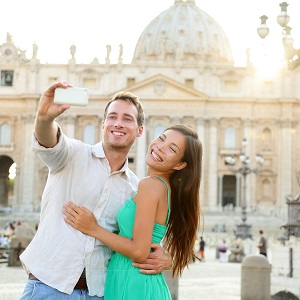Vatican City is flooded with glorious attractions, but there is no greater place to visit than the famous St. Peter’s Square.
It is one of Europe’s most impressive squares, home to St Peter’s Basilica, arguably the largest building in the Vatican City.
The History of St. Peter’s Square
The original purpose for the square was to have the greatest number of people to see the Pope give his blessing, but St. Peter’s Square became much more than this. From 1656 to 1667, Pope Alexander XII oversaw Gian Lorenzo Bernini’s project of creating this lasting piece of history. Though Bernini’s work on the square-ended in 1667, his pupils continued, adding the 140 statues to the columns in 1670. The Royal staircase was also constructed at a similar time, with these stairs linking the square to the Vatican Palaces.
The Design of St Peter’s Square
The entire square is a work of art, stretching 320 meters long and 240 meters wide. It is so large, St. Peter’s Square can hold more than 300,000 people, and is frequently used for religious events and festivals. One of the most impressive features of the square is its artistic features, with 284 columns and 88 pilasters that edge along the square. The columns are simple pieces created this way to direct the eyes of the viewer to the front of the basilica. Above the row of columns, there are 140 statues, said to watch over the square and its occupants.
In the centre of the square lie two fountains, each built by Carlo Maderno and Gian Lorenzo Bernini. Both of these fountains were constructed during the renaissance period, creating a beautiful and relaxing atmosphere within the square. The Bernini Fountain was created in the years 1667 to 1677. Whereas the Maderno Fountain, found on the left, was rebuilt in 1612 Pope Paul the V, as it was once an ancient Roman aqueduct.
However, arguably the greatest installation is the obelisk, nestled in the very heart of the square within the two fountains. This spectacular piece stands at 25 meters high and travelled from Egypt to Rome in 37 AD by Emperor Caligula. When it first stood in Rome, it was not a religious symbol, but instead a feature to the Roman Emperor. Only travelling to the square in 1586.
When to travel to St. Peter’s Square
Several important religious events are worth the visit to the square for! Located at the front of the basilica is a large balcony, used by the Pope when conducting these ceremonies. Many locals and tourists stand around the square for a chance to see the Pope emerge.
Explore the Vatican Tours
-
Rome Day Tour with Vatican & Colosseum
9 Hours
€95
See More -
Morning Vatican & Sistine Chapel Tour
3 Hours
€85
See More -
Extended Vatican Museums & Gardens Tour
5 Hours
€99
See More -
Vatican & Sistine Chapel Night Tour
2 Hours
€59
See More





